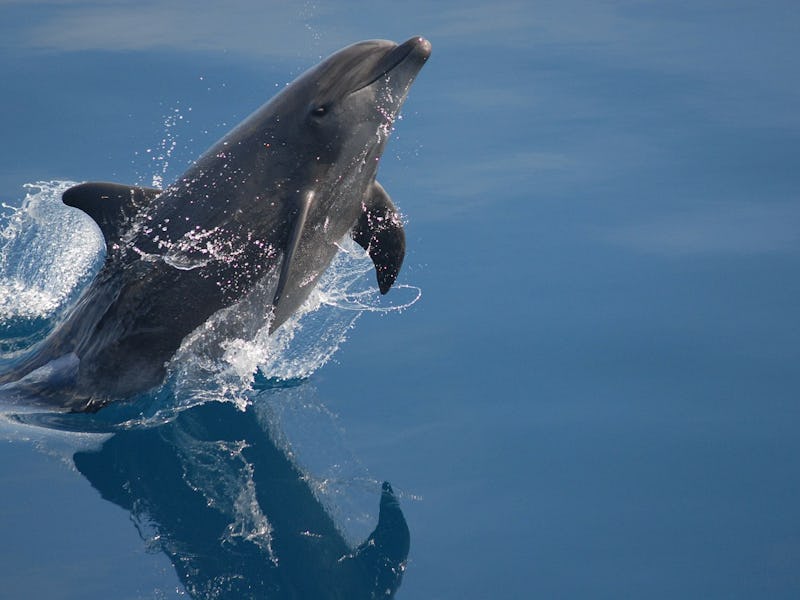Human-Fueled Superbugs Are Putting This Intelligent Animal in Danger
Dolphins reflect the alarming trend seen in US hospitals.

As hospitals grapple with the growing problem of superbugs, a threat that could cost 10 million lives a year by 2050, new research suggests that humans aren’t the only animals that these serious, difficult-to-treat infections could affect.
It seems we may be spreading our problems to the marine community, too.
Bottlenose dolphins off the east coast of Florida gained antibiotic resistance similar to what we see in humans, shows a study published Sunday in the journal Aquatic Mammals. Researchers tracked potential pathogens in the dolphins over 13 years in Florida’s Indian River Lagoon, an area that’s already had to deal with sewage spills and bacteria that’s harmful to humans.
The increasing resistance is a sign that human activity is affecting the coastal environments where the dolphins live, Florida Atlantic University epidemiologist Adam Schaefer, M.P.H., tells Inverse in an email.
“Unlike humans, wild dolphins are not taking antibiotics so the findings were a surprise to some extent,” he says.
Bottlenose dolphins (Tursiops truncatus) in Florida's Indian River Lagoon.
Schaefer says that either antibiotic-resistant bacteria are being released into the water or antibiotics are being discharged, affecting bacterial populations.
“Both processes are likely going on,” he says.
The findings raise concerns for us terrestrial mammals, as they show that aquatic environments could become reservoirs for antibiotic-resistant pathogens. They could include the kinds that affect humans, who also spend time in and around the ocean. In the United States, at least 2 million people get an antibiotic-resistant infection each year, and at least 23,000 people die, reports the Centers for Disease Control and Prevention.
For the study, Schaefer’s team isolated 173 pathogens collected over 13 years. These pathogens were cultured from samples obtained by swabbing the blowholes, gastric fluid, and feces of 171 dolphins captured and released back into the Indian River Lagoon.
Of those 173 pathogens, 88 percent were resistant to at least one type of antibiotic, and several showed big increases in antibiotic-resistance. E. coli, for example, which is the leading cause of urinary tract infections in the United States, doubled its resistance to an antibiotic called ciprofloxacin. The increase echoes the growing resistance seen in US hospitals, where drug-resistant UTIs are increasingly worrisome.
Members of the Health and Environment Risk Assessment (HERA) project examine a dolphin.
Bacteria called Pseudomonas aeruginosa, which can cause UTIs as well as respiratory infections in humans, saw the highest numbers and became significantly more resistant during the study.
“[Antibiotic resistance] was once just a major problem in healthcare settings but now [antibiotic resistance] is being seen in the community and environment,” Schaefer says.
In the ocean, antibiotic resistance genes can be exchanged among bacteria, spreading resistance into bacteria that cause disease in humans. Antibiotic-resistant diseases are difficult to treat, since there are fewer options that will work against them. And a person can spread an antibiotic-resistant disease to someone else without even knowing they had an infection.
“Often patients simply carry them without any consequence or infections, but then they go to other vulnerable patients and they may get infections that could prove serious to them,” Lona Mody, M.D., and Kristen Gibson, M.P.H., told Inverse earlier this year.
Abstract: Increases in resistance to commonly used antibiotics have been reported globally in isolates from humans, wildlife, and the environment. To date, few studies have examined long-term trends in antibiotic resistance in organisms isolated from marine mammal populations. The objective of this study was to examine temporal trends in resistance to antibiotics among pathogens isolated from common bottlenose dolphins (Tursiops truncatus) between 2003 and 2015. Dolphins were captured and released in the Indian River Lagoon, Florida, an ecosystem with a large coastal human population and significant environmental impacts. Swab samples for microbiology were taken from the blowhole, gastric fluid, and feces and cultured on standard media under aerobic conditions. Isolates were identified using gram stain morphology and growth on selective media. Antibiotic resistance was measured using disc diffusion on Mueller Hinton agar and the Multiple Antibiotic Resistance (MAR) index calculated for each pathogen. A total of 733 isolates was obtained from 171 individual dolphins. The most commonly cultured pathogens included Aeromonas hydrophila, Escherichia coli, Edwardsiella tarda, and Vibrio alginolyticus. The overall prevalence of resistance to at least one antibiotic for the 733 isolates was 88.2%. The MAR index increased significantly between 2003 and 2007 and 2010 and 2015 for Pseudomonas aeruginosa and V. alginolyticus. For all bacterial isolates, resistance to cefotaxime, ceftazidime, and gentamicin increased significantly between sampling periods. This is one of few studies to use the MAR index for bacterial isolates from a marine mammal. The significant increases in resistance for some bacterial species likely reflect shared environmental exposures to antibiotics and transfer of resistance to dolphins from terrestrial sources or from animal or human populations.